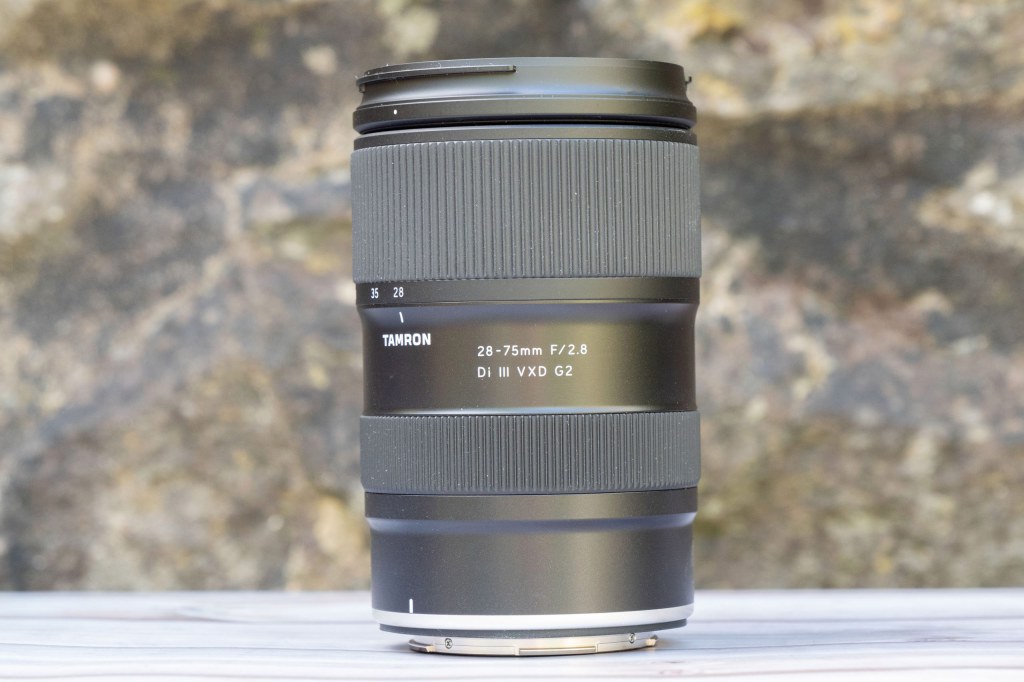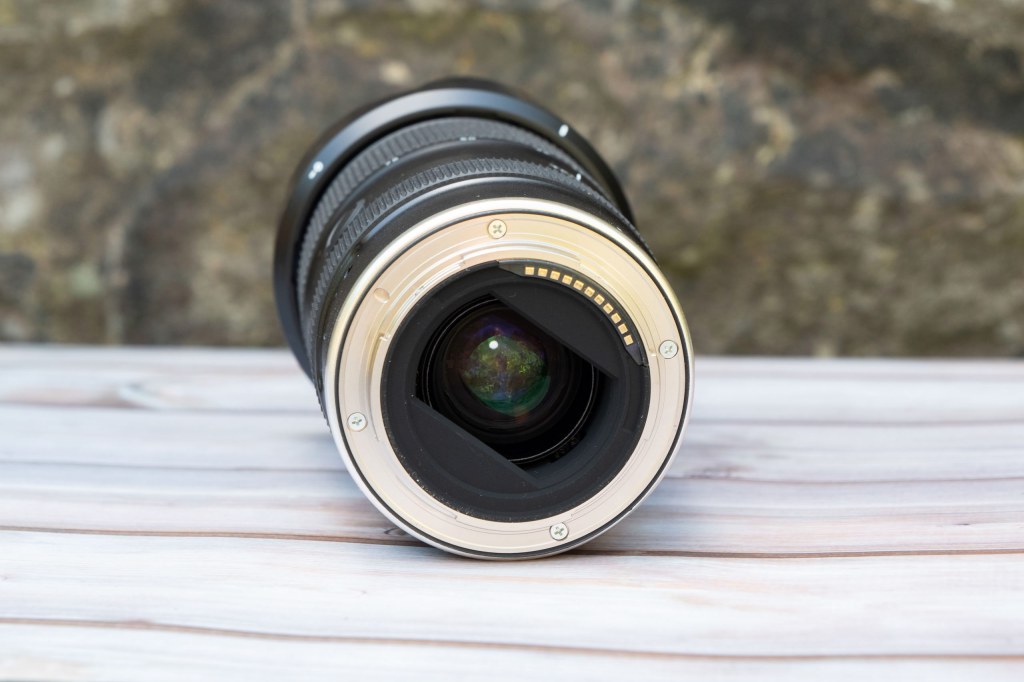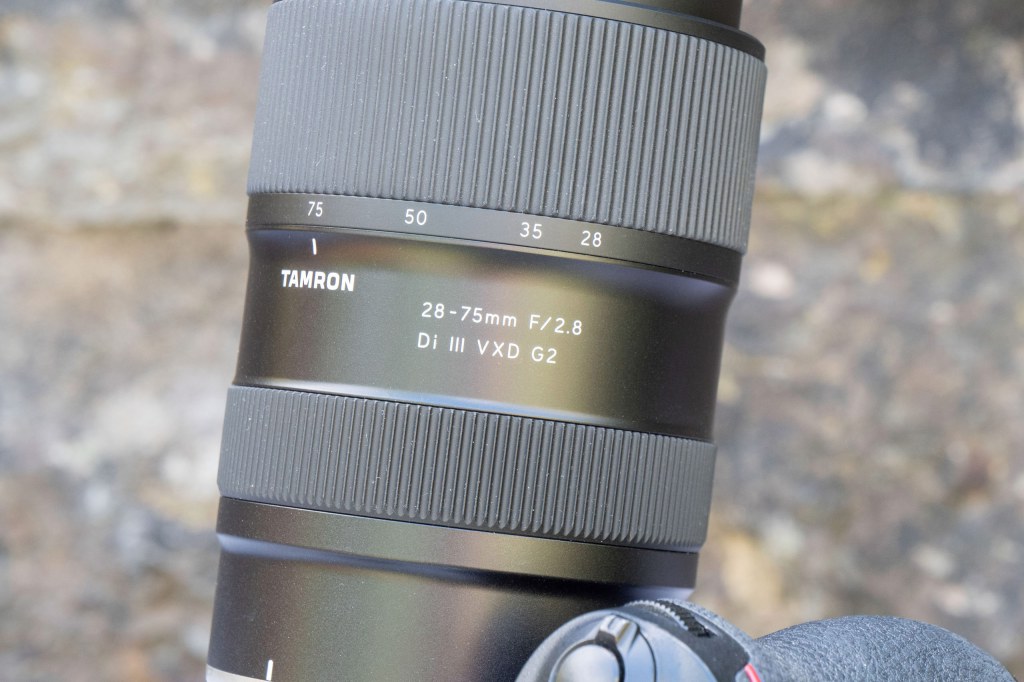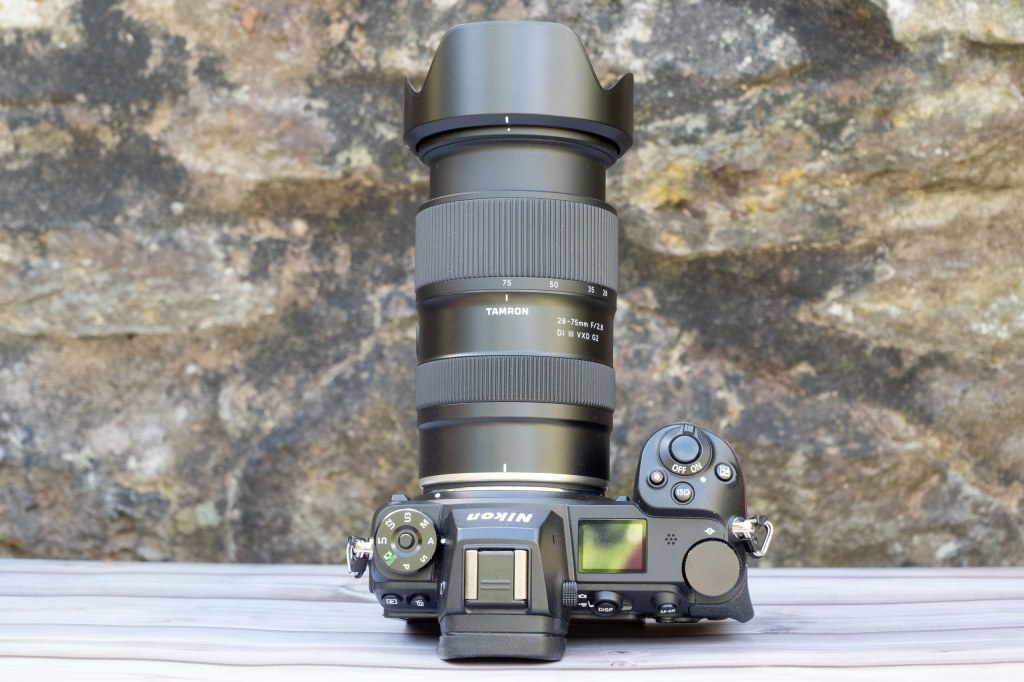Amateur Photographer verdict
Overall, the Tamron 28-75mm F/2.8 Di III VXD G2 is an excellent choice for an all-rounder lens that comes well recommended.- Constant f/2.8 aperture
- Lightweight
- Good value
- Not 24mm at wide-angle end
Making its way onto the market in April 2024, the Tamron 28-75mm F/2.8 Di III VXD G2 lens is designed as a standard zoom for covering off a range of different subjects while also being relatively compact for everyday and travel usage. It is available for Nikon and Sony users, and it may make it to our best Z mount lenses for Nikon list.
At a glance:
- Price: $779 / £849
- Large-aperture standard zoom
- Aperture: f/2.8-f/22
- Min focus: 0.18 – 0.38m
- 67mm filter thread
- 78.8mm diameter, 117.6mm length, 540g
- Nikon Z Mount / Sony E Mount
Starting at a little narrower than a typical 24-70mm f/2.8 lens, this lens is well-suited to subjects including landscapes, portraits, street and even some close-ups.
As we’d expect from a third-party lens, one of the major benefits of this lens is also its price. Costing £849, it’s a much more affordable outlay than the Nikon 24-70mm f/2.8 lens, which will set you back £1,889. Alternatively, there’s also a Nikon 24-70mm f/4 lens, which is currently priced around £949.
It’s worth noting that Nikon also has its own 28-75mm f/2.8 lens, which although its RRP is £899, you can pick it up for more like £800 at the moment, making it cheaper than the Tamron. It’s worth pointing out however that the Nikon 28-75mm f/2.8 has near-identical specification to the original Tamron 28-75mm F/2.8 Di III RXD for Sony E-mount, which made its debut in 2018 and is the predecessor to the lens being reviewed here.

Tamron claims that the 28-75mm f/2.8 G2 lens will have the “highest image quality, high-speed AF and high-cost performance in the market for fast aperture zoom lenses for Nikon Z mount”.
A number of improvements have been made for the G2 version of the lens over the original. So although it makes its debut for the first time on a Nikon Z model, you might also consider buying it for Sony E-Mount even if you have the first iteration. Upgrades include an improved lens barrel design, faster autofocus, better close-up focusing and promised improved image quality, too.
The lens is designed to be used with Nikon’s full-frame models, such as the Nikon Z7 II, Nikon Z8 or Nikon Z6 II. You could theoretically use it with Nikon’s APS-C cameras like the Nikon Z50, but you’d end up with an equivalent focal length of 42-112mm, which is perhaps a less appealing prospect. As mentioned, you can also use it with Sony E Mount cameras. Again, full-frame models like the Sony A7 IV would probably be the most likely candidate to use it with.
Tamron 28-75mm F/2.8 Di III VXD G2 – Features
The lens construction of the Tamron 28-75mm F/2.8 Di III VXD G2 consists of 17 elements in 15 groups, to include two LD (Low Dispersion) and GM (Glass Molded Aspherical) elements which are designed to control optical aberrations. Additionally, there is a fluorine coating for the front element to repel dirt and water, while the lens itself is also sealed to make it splash-resistant.
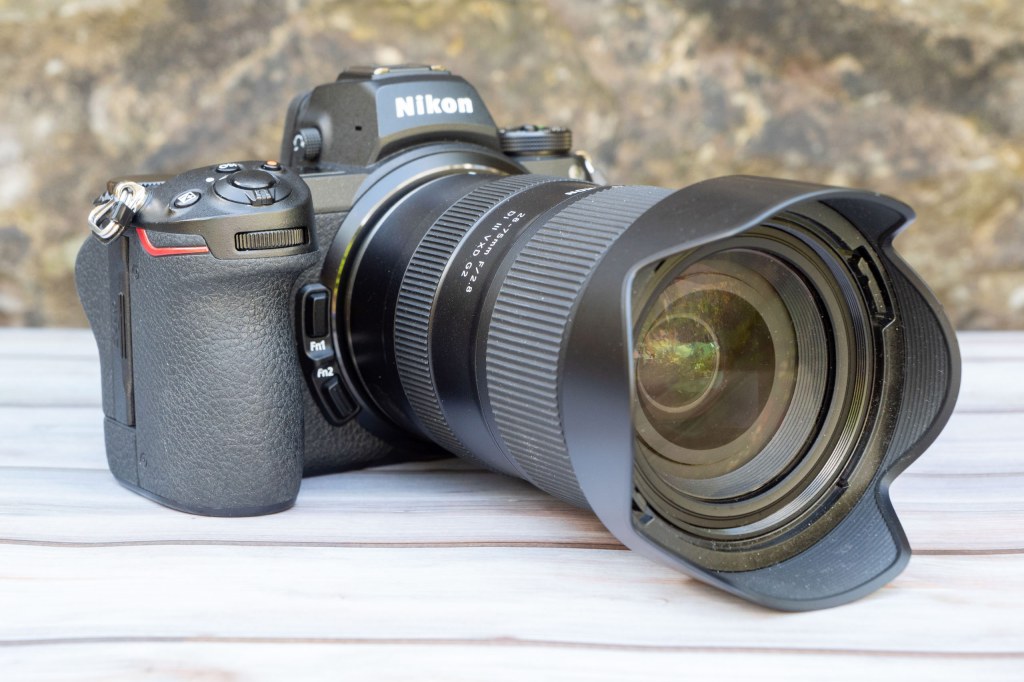
Bokeh is created by the nine aperture blades. The constant f/2.8 aperture allows for shallow depth of field effects to be created throughout the zoom range.
While this isn’t specifically designated as a macro lens, it has a minimum focusing distance of 0.18m at the wide-angle end, or 0.38m at the telephoto end. Considering this distance is measured from the sensor, rather than the end of the lens, you can get very close to the subject for frame-filling shots at either end of the zoom range. The maximum magnification ratio is 1:2.7 (wide angle) or 1:4.1 (telephoto). This is an improvement from its predecessor, which had a 0.19 closest focusing distance and a 1:2.9 maximum magnification ratio.

The VXD in the lens name refers to its autofocusing system. VXD (Voice-coil eXtreme-torque Drive) is designed to be fast and precise, but also quiet, which should come in handy for recording video.
No inbuilt stabilisation is included with this lens. This isn’t particularly surprising at these focal lengths, while all of Nikon’s full-frame Z models have in body stabilisation too, as do all of Sony’s current full-frame line up.
Tamron 28-75mm F/2.8 Di III VXD G2 – Build and Handling
Generally speaking, when it comes to standard zooms, your choices are big and bulky with a wide aperture, or, slim and compact with a narrower one. The Nikon Z 24-70mm f/4 is a favourite of mine for its versatility and compact size, but there are plenty of occasions when I wish I had those extra f-stops. Meanwhile, the Nikon Z 24-70mm f/2.8 is undoubtedly a fantastic lens, but its heft makes it difficult to justify carrying around just on the off-chance you’re going to use it. Then there’s the price issue too.
Here, however, with the Tamron 28-75mm f/2.8, you pretty much get the best of both worlds. You get that lovely wide aperture, but you also get a lens which is pleasingly compact and relatively light. Of course, the compromise is that you have to start at 28mm, rather than 24mm, but you can’t have absolutely everything.
Whether you’re willing to let go of the extra 4mm is a matter of personal preference, or perhaps more accurately, a matter of what you like to shoot most often. If you’re frequently photographing things like architecture, you might miss it. But for other subjects, such as portraits, it’s arguably less important.
Overall, the lens balances well with models such as the Nikon Z7 II that I’ve been using it with. At 550g, it’s only marginally heavier than the 500g Nikon 24-70mm f/4 lens. It might feel a little front heavy on one of Nikon’s APS-C models, but that’s a very minor concern considering it’s not really aimed at that audience.


This lens is an update of an earlier lens, and as such, the design has been updated. This includes a reworking of the internal parts of the zoom ring and focus ring to make it smoother to use. It’s also a little slimmer than the previous version, which allows for a contoured profile where the zoom and focus rings stick out slightly from the lens body. This makes it easier to grip naturally.
On top of that, abrasion resistance has been added to make it more difficult to scratch the lens barrel, as well as resisting fingerprints. I’m happy to report that so far this seems to be true with neither appearing on my lens during my time with it.
The outward design of the lens is relatively straightforward. At the front of the lens is a zoom ring which takes up about a third of the lens. It is marked with 28, 35, 50 and 75mm focal lengths and is stiff enough to make incremental changes accurately. There’s no lock on the zoom ring to keep the lens in place, but zoom creep doesn’t seem to take place when you’re walking around with it.
Towards the back of the lens is a ring which can be used for manually focusing, but it can also be set to control aperture, exposure compensation or ISO too (when using a Nikon camera). Alternatively you can set it to control nothing at all if you don’t want to risk accidentally knocking it out of place.
A button in between the lens ring and the zoom ring can be set to control many different functions. With some functions, you’ll need to hold the button down to use it, with others it’ll be a tap on, tap off process. Just behind the focusing ring is a USB-C port. This allows you to hook the lens up to Tamron Lens Utility to customise certain functions of the lens, as well as update the firmware.
Tamron 28-75mm F/2.8 Di III VXD G2 – Autofocus
Autofocus is another area where this lens has improved over its predecessor. It now promises that AF speed is twice as fast as the first generation model thanks to the VXD linear motor focus mechanism.
It certainly is speedy, going from close to distant subjects very quickly indeed and without hesitation. It takes ever so slightly longer in darker conditions, but it’s a lens I’d be happy to use for situations such as events or weddings where speed is of the essence.

In terms of audio levels, you can just about hear the focusing mechanism if you sit in a silent room and place the lens next to your ear while it focuses – but it’s certainly not loud enough to bother the average subject or to appear on video recordings.
Tamron 28-75mm F/2.8 Di III VXD G2 – Image Quality
At this lens’ price point, we wouldn’t usually expect ultimate sharpness, but the lens is impressively very capable of producing some excellent images. Images are sharp throughout the focal range, with no obvious drop off in sharpness towards the edges of the frame.

It’s probably fair to say that there’s more sharpness on display here than the average person will make use of. I’ve been particularly impressed with how well macro-type subjects come out, as well as the fine detail displayed with things like fur.

Having the maximum f/2.8 aperture available throughout the zoom range makes it great to use in lower light conditions, but also enables some very attractive shallow depth of field effects. Although the quality of bokeh is often somewhat subjective, here we see some beautifully smooth and rounded out of focus areas in the appropriate shooting scenarios.

Further good news is that even when shooting wide open, there’s no obvious vignetting. Distortion is well-controlled, with the camera’s own correction doing an excellent job of keeping things looking accurate. Chromatic aberrations don’t seem to be a problem, even when shooting in bright, high-contrast conditions either.
Overall the image quality is excellent considering the versatility it offers, especially for the cost.
Tamron 28-75mm F/2.8 Di III VXD G2 – Verdict
All-purpose walk around zoom lenses are something that pretty much every photographer should have in their kit bag. For many using the Nikon Z system, that will in all likelihood be the 24-70mm f/4 lens, which is an excellent, versatile and travel-friendly lens. But for those that crave having an f/2.8 lens for this purpose, then this Tamron option poses an interesting proposition.

It’s reasonably compact and lightweight, and won’t cost you a fortune, which it sets it apart from Nikon’s 24-70mm f/2.8 Z lens. There’s very little not to like about the Tamron 28-75mm – not withstanding that 28mm isn’t quite as nice as 24mm for subjects such as landscapes and architecture.
Naturally, it’s very similar to Nikon’s own 28-75mm f/2.8 lens, which appears to have been based off this Tamron lens’ predecessor. If you’re stuck between the two, I’d opt for the newer Tamron G2 version. It’s sharper and faster-focusing yet is similarly priced. Don’t be fooled into thinking that something proprietary is better quality – in this instance, it really isn’t. For Sony users, it’ll be an excellent choice, too – although there’s more competition available for the E mount.

Overall, the Tamron 28-75mm F/2.8 Di III VXD G2 is an excellent choice for an all-rounder lens that comes well recommended.

Tamron 28-75mm F/2.8 Di III VXD G2 – Full Specifications
| Price | $779 / £849 |
| Filter diameter | 67mm |
| Lens elements | 17 |
| Groups | 15 |
| Diaphragm blades | 9 |
| Aperture | f/2.8-f/22 |
| Minimum focus | 0.18m-0.38m |
| Length | 117.6mm |
| Diameter | 78.8mm |
| Weight | 550g (Nikon mount), 540g (Sony E mount) |
| Lens Mount | Nikon Z, Sony E |
| Included accessories | Caps, hood |
Related reading:
- Best zoom lenses for Sony
- Tamron 17-50mm F/4 for Sony E-mount here next month
- Tamron 70-300mm f/4.5-6.3 Di III RXD for Z mount
Follow AP on Facebook, Twitter, Instagram, YouTube and TikTok.


